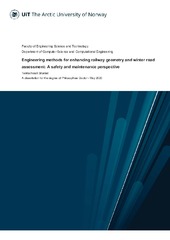| dc.contributor.advisor | Grimsbø, Endre | |
| dc.contributor.author | Fauske, Åse Nordahl | |
| dc.date.accessioned | 2022-08-18T05:34:21Z | |
| dc.date.available | 2022-08-18T05:34:21Z | |
| dc.date.issued | 2022-06-25 | en |
| dc.description.abstract | Radomes are dome-shaped covers that protect the antenna from the climate, such as rain, wind, sunlight, and snow. Even though the radomes protect the antenna from snow and ice, it does not prevent snow and ice from building up on the radome. When snow and ice build up enough on the radome, the signal passing through it loses strength. This project tries to detect snow and ice build-up on antenna radomes using the antenna's signal strength and pointing angle. This project has two goals; first is to see if signal processing can be used to detect snow only by looking at the signal strength and pointing angle, and second is to see which analysis tool gives the best results. The data used in this project is the orbital passes of satellites with a signal connection between the antennas and satellites.
The data was first manually classified within the two classes representing the presence of snow or no snow. Then, the analysing tools are applied to the data. The analysing tools used in an attempt to detect the snow and ice build-up are the Fourier Transform and the Linear Discriminant Analysis. First, the Fourier Transform was used to see if the frequency information could be used to distinguish between the classes. Then, the Linear Discriminant Analysis was applied to the data with both the Short Time Fourier Transform and the Fourier Transform. For the last Linear Discriminant Analysis application, the data was segmented.
The classes were not easily distinguished in the frequency domain, but using the Linear Discriminant Analysis and adding descriptive statistics made the difference between the classes was easier to detect. The best results were achieved using the Linear Discriminant Analysis and only looking at a small segment containing the highest elevation angles of each orbital pass. | en_US |
| dc.identifier.uri | https://hdl.handle.net/10037/26260 | |
| dc.language.iso | eng | en_US |
| dc.publisher | UiT The Arctic University of Norway | en |
| dc.publisher | UiT Norges arktiske universitet | no |
| dc.rights.holder | Copyright 2022 The Author(s) | |
| dc.rights.uri | https://creativecommons.org/licenses/by-nc-sa/4.0 | en_US |
| dc.rights | Attribution-NonCommercial-ShareAlike 4.0 International (CC BY-NC-SA 4.0) | en_US |
| dc.subject.courseID | TEK-3901 | |
| dc.subject | VDP::Matematikk og Naturvitenskap: 400::Matematikk: 410::Anvendt matematikk: 413 | en_US |
| dc.subject | VDP::Mathematics and natural science: 400::Mathematics: 410::Applied mathematics: 413 | en_US |
| dc.subject | VDP::Matematikk og Naturvitenskap: 400::Matematikk: 410::Analyse: 411 | en_US |
| dc.subject | VDP::Mathematics and natural science: 400::Mathematics: 410::Analysis: 411 | en_US |
| dc.subject | VDP::Matematikk og Naturvitenskap: 400::Informasjons- og kommunikasjonsvitenskap: 420::Simulering, visualisering, signalbehandling, bildeanalyse: 429 | en_US |
| dc.subject | VDP::Mathematics and natural science: 400::Information and communication science: 420::Simulation, visualization, signal processing, image processing: 429 | en_US |
| dc.title | Snow detection on antenna radomes using signal processing | en_US |
| dc.type | Master thesis | |
| dc.type | Mastergradsoppgave | |


 English
English norsk
norsk



